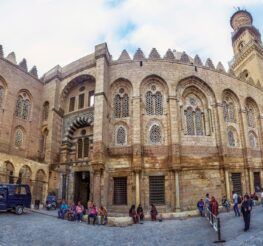In Photos: The Eerie Beauty of the City of the Dead

Cairo 360
Beyond the antiquities of our Pharaonic forefathers, Egypt is a land filled with hidden landmarks – ones that are as insightful to the country’s history as any Pyramid or museum.
Even Cairo, a bustling capital city of 21 million or so people, has its secrets and obscurities, not least the City of the Dead. Located below Mokattam Hills in the south east of the city, the area is essentially a necropolis; but over the centuries it has evolved into a living, breathing organism of its own that has managed to reach a certain degree of self-sufficiency. Though considered a slum – and it’d be hard to argue that – it also stands as one monument to Cairo’s colourful history.
Running along the city from north to south, the strip is around 6.4km long.
 Photo: Ahmed Darwish
Photo: Ahmed Darwish
The City of the Dead dates back to the Muslim conquest of Egypt in 642 AD, when Amr Ibn Al ‘as established a family graveyard at the foot of Mokattam.
 Photo: Ahmed Darwish
Photo: Ahmed Darwish
Many of the residents are said to have moved there to be close to deceased relatives.
 Photo: Ahmed Darwish
Photo: Ahmed Darwish
The very first residents are thought to have been custodians tending to graves and burial staff, as well as Sufi mystics.
 Photo: Ahmed Darwish
Photo: Ahmed Darwish
Under the Mamluk Sultanate, it was used for military parades, processions and ceremonies.
 Photo: Ahmed Darwish
Photo: Ahmed Darwish
 Photo: Ahmed Darwish
Photo: Ahmed Darwish
With a huge number of Sufi colleges and madrasas enclosed within the area, it became a something of a destination of pilgrimage, with many travelling there in search of blessings – or baraka.
 Photo: Ahmed Darwish
Photo: Ahmed Darwish
The City of the Dead houses a number of shrines for female saints, including Sayyida Zainab, Nafisa, Ruqqaya, Atika and Sukayna.
 Photo: Ahmed Darwish
Photo: Ahmed Darwish
 Photo: Ahmed Darwish
Photo: Ahmed Darwish
After the 1992 earthquake in Cairo, many were forced to flee their homes and reside in the tombs of relatives.
 Photo: Ahmed Darwish
Photo: Ahmed Darwish
It is estimated that around 500,000 people live in the City of the Dead.
 Photo: Anaelle Gabrieli
Photo: Anaelle Gabrieli
It has been something of a touristic site for centuries, with the likes of Moroccan scholar, Ibn Batuta –widely considered to be one of the greatest travelers in history – having visited and written about it.
 Photo: Ahmed Darwish
Photo: Ahmed Darwish
 Photo: Ahmed Darwish
Photo: Ahmed Darwish
 Photo: Ahmed Darwish
Photo: Ahmed Darwish
During the Mawlid of Zaynab bint Ali – an occasion known as El Leila El Kebira – residents decorate the City of the Dead with various coloured and patterned tents.
 Photo: Ahmed Darwish
Photo: Ahmed Darwish
 Photo: Ahmed Darwish
Photo: Ahmed Darwish
The neigboourhood is also referred to in Arabic as Al Gabana or Al Qarafa, the latter of which is believed to have been named after a Yemeni tribe called Qorafa, who are said to have lived there.
 Photo: Anaelle Gabrieli
Photo: Anaelle Gabrieli
 Photo: Anaelle Gabrieli
Photo: Anaelle Gabrieli
It’s as nontraditional a spectacle as you’ll find in all of Egypt and many hold hesitations in visiting it – hesitations that would, to a certain extent, be justified. After all, this is not a touristic sight, but a functioning neighbourhood (it has a medical centre and post office). There’s a sense of intrusion that one can’t help but feel; at the same time however, there are few more welcoming people than the residents of the City of the Dead. They generally hold a sense of curiosity as to why anyone would visit the area, but are incredibly welcoming to visitors all the same.
recommended
 Arts & Culture
Arts & Culture
The Coptic Museum: The History of Egypt to the Tunes of Psalms of David
arts & culture cairo museums +4 Health & Fitness
Health & Fitness
Egyptians in the 2024 Summer Olympics
Egyptians in the Olympics Olympics +1 City Life
City Life
Weekend Guide: Bazar by Sasson, Memo, The Cadillacs, Heya Bazaar, Dou, Nesma Herky & More
Concerts The Weekend Guide +2 Arts & Culture
Arts & Culture

